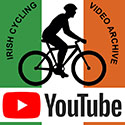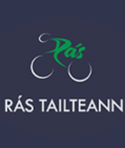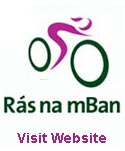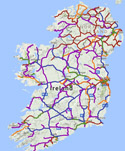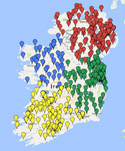This article is going to look at neck pain from cycling. Neck pain is reported to account for 10-30% of pain experienced by cyclists. Neck pain can be linked to the cyclist’s position on the bike as well as other day to day activities. This article is aimed at discussing neck pain experienced after cycling. As the neck is a delicate area, if you experience neck pain outside of cycling, it is best to get it checked out by a Physical Therapist or Doctor prior to doing any of the exercises included here.
Neck pain, where it’s felt….
Pains in the neck can be felt in different areas in the neck depending on the person and the position that they adopt on their bike. Some feel it low down on the top of the shoulder, or top of the shoulder blade in the upper back, others point to half way up their neck, and some feel it under where the skull meets the top of the neck.
The onset of neck pain can depend on the type of cycling you are doing. If you are down on the tri bars or the drops you may feel it come on quicker than you would when on the brake hoods or top of the bars.
What causes it….
Cycling triggers
Neck pain is caused by tightening of the muscles that extend the neck during cycling. When you are in an upright position, sitting or standing, your neck is in a neutral position to look around and in front of you. When you adopt a flexed trunk position as in cycling, the neck then has to extend to be able to see in front of you rather than looking at the ground. The more flexed a position you adopt on the bike the more extension that is required from the neck. Muscles that hold the neck in extension can tighten, or fatigue leading to neck pain. Trigger points – knots of tender muscle – develop which can refer pain up to the head, ear, above the eyes, down into the arms, or around the shoulder blade.
When you adopt a low position like in the drops, or on the tri bars, your shoulder position also changes. The shoulders come up closer to the ears to create a tighter, more aerodynamic position. This can also be the case when cycling with straight arms. The muscles that bring the shoulders closer to the ears are also involved in the extending the neck which increases the tightness or fatigue in the muscles. Hyperextension of the neck can also be increased by top tubes that are too long for the cyclist. Track cycling can also contribute to neck pain, because when cycling at high speeds the neck has to withstand the g-forces that are involved on the bends.
Look at these images for comparisons of cyclists in different positions:
In this first image the cyclist’s necks and heads are in various positions, some are looking down, others to one side, and others up. There is some flexion in the elbows. There is a lot of neck movement which can reduce the amount of neck discomfort felt.

In this image the cyclist is in down in the drops – the back is flexed, the elbows are more flexed than the image above and neck is extended. There is less looking around as the focus is on something or someone ahead.

Tightest position of all. Note the low position of the back in this picture, the elbows are nearly at 90° of flexion and the neck is extended to look ahead. Contrast this to the position of the cyclists in the above pictures.

Accidents such as crashes also cause neck pain as the muscles in the neck work to protect the neck from forces as the body is thrown from the bike. Muscle strains can result and there may be disruption to the alignment of vertebrae. In severe cases ligaments can be sprained or torn and vertebrae fractured. In the event of neck pain after a crash an assessment by a doctor is recommended to rule out any problem that may require medical intervention. When suitable, Physical Therapy can then be used to treat and rehabilitate the neck.
Non cycling triggers…..
Day to day activities can also be a contributor to neck pain, and it is important to consider these when trying to resolve your pain. Sitting hunched over laptops, keyboards, books, or work areas, or sleeping in chairs or on airplanes can lead to tightening neck and shoulder muscles. When looking at computer screens in front of us we often poke our chins out, this creates a hypertension of the skull on the upper neck.
Working at high tables or benches can lead to neck pain as you raise your shoulders up towards your ears so your hands can work at the table. In addition without knowing it we can often carry stress or worries in the shoulder, tensing the muscles in the shoulder and neck leading to knots and pain.
Signs and symptoms of Neck Pain
- When the muscles fatigue or shorten then they can cause the following:
- Feeling of stiffness
- Reduction in range of movement e.g. rotating or side-bending the head due to tight muscles
- Development of trigger points (tender knots) which can refer pain down the arm, into the shoulder blade, up the neck, and into the head depending on their location.
- Headaches, sometimes called tension headaches. These are the same headaches associated with colds, flu’s or blocked sinuses.
- Some pins and needles into the arm may be noticed but if the neck pain is associated with any of the following nausea; numbness; loss of balance; unremitting headache; gross loss of movement or severe pain with movement; changes in vision such as blurriness, seeing stars, or loss of vision; or a metallic taste in the mouth, a doctor should be consulted to rule out any non-muscular causes of the neck pain.
How to help yourself
Bike Specific
- When out on the bike training or, if possible, depending on the type of racing, sit up and perform some neck and shoulder rolls.
- Cycle with some bend in the elbows rather than straight arms. This will prevent your shoulders being up by your ears, but also help with shock absorption, preventing these shocks heading into the shoulders and neck.
- Review your head position on the bike. The further down the road you are looking the more extension of the neck. Try focus on the few meters ahead to prevent too much neck extension, looking further ahead when you need to.
- Check the length of your bike and ensure your top tube length is correct for you. This could be adjusted by changing saddle position - not recommended, better to change the stem only (and watch out for knee injury!) -, or using a stem with a shorter length. Raising handle bars or using handle bars with a shallower drop would help reduce the amount of neck hyperextension.
Off the Bike
- Stretch the muscles around the neck and shoulders after training. See exercises below.
- Heat, for example, via a hot shower or a heat pack applied around the upper shoulders and neck may help give some relief from neck pain
- Get a massage to loosen out the neck and shoulders, or ask your massage therapist to include the neck as part of your normal massage routine
- If neck pain is not relieved by massage or the pain is recurring go to a Physical Therapist for further examination. A Physical Therapist can assess the neck and determine if there are any problems with the vertebral alignment as well as muscle imbalances. These can be corrected via mobilisations and soft tissue work, and a rehabilitation programme prescribed to strengthen the neck and prevent further problems.
At work, Home or Travelling
- Take a look at your set up at work as it could be predisposing you to neck pain:
- If working on a laptop place it on a desk not your knees. Use a riser to raise the screen up so your eyes are level with the top third of the screen. You will need to attach a keyboard and mouse to use the laptop in this position
- If using a desktop raise the screen up so the eyes are level with the top one third of the screen
- Chair to table level. Adjust your chair height or table height so when you are sitting your elbows can sit on the table top without having to raise the shoulders i.e. the shoulders should be relaxed.
- Worktop level: the ideal height is where your elbows can sit on the table top without having to raise the shoulders.
- Arrange your desk or worktop so the main items you use are reachable when your elbows are tucked close by your side. This prevents over reaching.
- Stretch or move the neck and shoulders at regular intervals to stop them tightening up
- Also consider your activities at home; do you use your laptop on your knees, or on the kitchen table, does your pillow contribute to neck pain? Review the tips for the workplace as these also apply to using laptops and working at home. Pillows can also contribute to neck pain. Ideally your pillow should support your head so when lying on a pillow your head is in a neutral position. A pillow too high will flex your head when lying on your back, or side bend it towards the ceiling it when lying on your side and vice versa for a low pillow.
- Travelling can contribute to neck pain particularly when sleeping in a seated position on flights, in the car, or train as the neck is not well supported. Consider the use of neck pillows to try give you support and stretch your neck regularly when flying.
Exercises
IMPORTANT: Before undertaking any new exercises you should contact a Doctor or Physical Therapist to make sure that they are appropriate for you do. Without doing so, carrying out any exercises described in this article is at your own risk.
Shoulder Rolls
- Rotate the shoulders backwards in circles making sure to go into the full pain free range available i.e. bring then right back, all the way down, fully forward, up to the ears and back to the start.
The next two stretches, stretch the muscles from the shoulder up to the neck. They will be described for stretching the right side, so reverse the exercise to stretch the left side. The stretch should be mild. Over stretching, that is when feeling a ‘strong’ stretch, can lead to stiffness the next day.
Stretch for the right Trapezius
- Drop/depress the right shoulder towards the floor.
- Bring the chin to the chest. Bring your the ear towards the left shoulder, and turn the chin slightly towards the right.
- Hold the stretch for 10 seconds and repeat 3 times on each side.
 |
 |
 |
| Starting Position | Depress the right shoulder | Side bend the head towards the left and while maintaining this position turn the chin towards the right |
Stretch for the right Levator Scapula
This stretch is similar for the Trapezius except the direction in which you turn your head differs.
- Depress the right shoulder towards the floor.
- Bring the chin to the chest. Bring the left ear towards the left shoulder, and turn the chin slightly towards the left.
- Hold the stretch for 10 seconds and repeat 3 times on each side
 |
 |
 |
| Starting Position | Depress the right shoulder | Side bend the head to the left and keeping the head side bent turn the chin to the left |
Stretch for upper neck
Placing a finger on the chin, tuck the chin back. A slight stretch may be felt at this point where the skull meets the upper neck
If not, using the other hand behind the head push the head gently upwards and forward. See diagram. Hold for 10 seconds.
|
|
References:
Brukner P, Kahn K 2007. Clinical Sports Medicine 3rd Edn. McGraw-Hill, North Rhyde
Callaghan M, Jarvis C 1996. Evaluation of elite British cyclists: the role of the squad medical. British Journal of Sports Medicine 30, 349-353
Dannenberg AL, Needle S, Mullady D, Kolodner KB 1996. Predictors of injury among 1638 cyclists in a recreational long-distance bicycle tour: Cycle across Maryland.
American Journal of Sports Medicine 24, 747-53
Hertling D, Kessler R 2006. Management of Common Musculoskeletal Disorders 4th edn. Lippincott Williams & Wilkins, Philadelphia
Mellion MB 1991. Common cycling injuries. Management and prevention. Sports Medicine 11, 52-70
